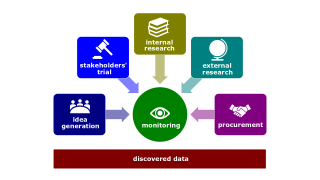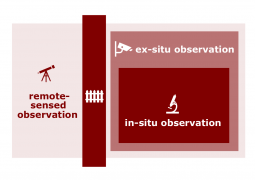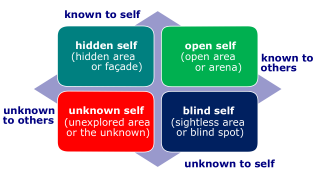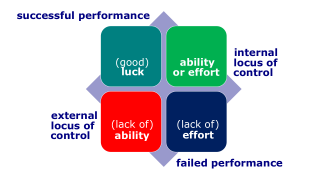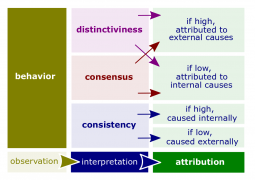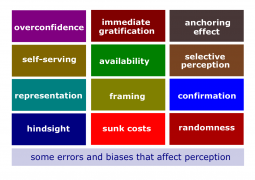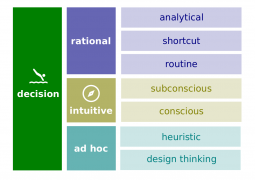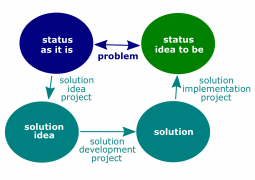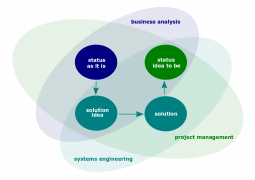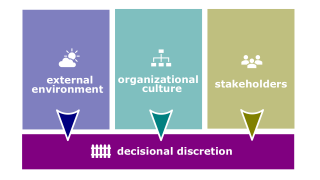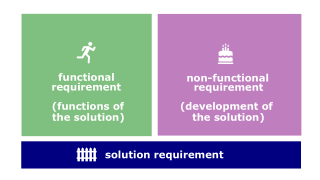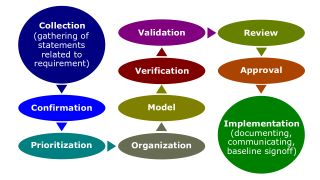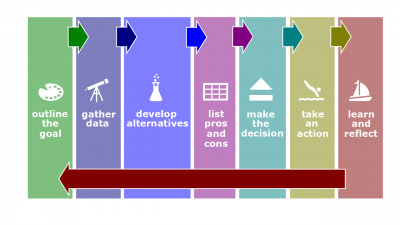Difference between revisions of "OB intent concepts"
(→Perception) |
|||
| (3 intermediate revisions by the same user not shown) | |||
| Line 10: | Line 10: | ||
</gallery> | </gallery> | ||
| − | ==Attribution in perception== | + | ==Attribution and biases in perception== |
*[[Attribution theory]]. An attempt to determine whether an individual's behavior is internally or externally caused. | *[[Attribution theory]]. An attempt to determine whether an individual's behavior is internally or externally caused. | ||
*[[Fundamental attribution error]]. The tendency to underestimate the influence of external factors and overestimate the influence of internal factors when making judgments about the behavior of others. | *[[Fundamental attribution error]]. The tendency to underestimate the influence of external factors and overestimate the influence of internal factors when making judgments about the behavior of others. | ||
| Line 19: | Line 19: | ||
*[[Stereotyping]]. Judging someone on the basis of our perception of the group to which that person belongs. | *[[Stereotyping]]. Judging someone on the basis of our perception of the group to which that person belongs. | ||
*[[Stereotype threat]]. The degree to which we internally agree with the generally negative stereotyped perceptions of our groups. | *[[Stereotype threat]]. The degree to which we internally agree with the generally negative stereotyped perceptions of our groups. | ||
| − | *[[Self-fulfilling prophecy]]. A situation in which a person inaccurately perceives a second person, and the resulting expectations cause the second person to behave in ways consistent with the original perception.<gallery mode="packed-hover" widths=300px> | + | *[[Self-fulfilling prophecy]]. A situation in which a person inaccurately perceives a second person, and the resulting expectations cause the second person to behave in ways consistent with the original perception. |
| + | <gallery mode="packed-hover" widths=300px> | ||
File:Attribution-theory.png|[[Attribution theory]] | File:Attribution-theory.png|[[Attribution theory]] | ||
File:Attribution-factors.png|[[Attribution factor]] | File:Attribution-factors.png|[[Attribution factor]] | ||
| Line 26: | Line 27: | ||
==Decision making== | ==Decision making== | ||
| − | * | + | *[[Decision]]. A choice made from among two or more alternatives. |
*[[Problem]]. A discrepancy between the current state of affairs and some desired state. | *[[Problem]]. A discrepancy between the current state of affairs and some desired state. | ||
| + | <gallery mode="packed-hover" widths="300px"> | ||
| + | File:Decision.png|[[Decision-making approach]] | ||
| + | File:Solution-project.png|[[Problem]], [[solution]], and [[project]] | ||
| + | File:Ba-pm-se.png|[[Business analysis]] vs [[project management]] vs [[systems engineering]] | ||
| + | File:Discretion.png|[[Decisional discretion]] | ||
| + | File:Requirement.png|[[Solution requirement]] | ||
| + | File:Requirement-lifecycle.png|[[Requirement lifecycle]] | ||
| + | </gallery> | ||
| + | |||
| + | ==Rational decision-making== | ||
*[[Rationale]]. A reasoning characterized by making consistent, value-maximizing choices within specified constraints. | *[[Rationale]]. A reasoning characterized by making consistent, value-maximizing choices within specified constraints. | ||
| − | *[[File:7-step-rational.png| | + | *[[File:7-step-rational.png|400px|thumb|right|[[Seven-step decision-making]]]][[Rational decision-making model]]. A decision-making model that describes how individuals should behave in order to maximize some outcome. |
| + | |||
| + | ==Errors in decision-making== | ||
*[[Bounded rationality]]. A process of making decisions by constructing simplified models that extract the essential features from problems without capturing all their complexity. | *[[Bounded rationality]]. A process of making decisions by constructing simplified models that extract the essential features from problems without capturing all their complexity. | ||
*[[Intuitive decision making]]. An unconscious process created out of distilled experience. | *[[Intuitive decision making]]. An unconscious process created out of distilled experience. | ||
| Line 39: | Line 52: | ||
*[[Risk aversion]]. The tendency to prefer a sure gain of a moderate amount over a riskier outcome, even if the riskier outcome might have a higher expected payoff. | *[[Risk aversion]]. The tendency to prefer a sure gain of a moderate amount over a riskier outcome, even if the riskier outcome might have a higher expected payoff. | ||
*[[Hindsight bias]]. The tendency to believe falsely, after an outcome of an event is actually known, that one would have accurately predicted that outcome. | *[[Hindsight bias]]. The tendency to believe falsely, after an outcome of an event is actually known, that one would have accurately predicted that outcome. | ||
| + | |||
| + | ==Ethics in decision-making== | ||
*[[Utilitarianism]]. A system in which decisions are made to provide the greatest good for the greatest number. | *[[Utilitarianism]]. A system in which decisions are made to provide the greatest good for the greatest number. | ||
*[[Whistle-blower]]. An individual who reports unethical practices by their employer to outsiders. | *[[Whistle-blower]]. An individual who reports unethical practices by their employer to outsiders. | ||
*[[Behavioral ethics]]. Analyzing how people actually behave when confronted with [[ethical dilemma]]s. | *[[Behavioral ethics]]. Analyzing how people actually behave when confronted with [[ethical dilemma]]s. | ||
| + | |||
| + | ==Creative decision-making== | ||
*[[Creativity]]. The ability to produce novel and useful ideas. | *[[Creativity]]. The ability to produce novel and useful ideas. | ||
| − | *[[Three-stage model of creativity]]. The proposition that [[creativity]] involves three stages: causes (creative potential and creative environment), creative behavior, and creative outcomes (innovation). | + | *[[Three-stage model of creativity]]. The proposition that [[creativity]] involves three stages: causes (creative potential and creative environment), [[creative behavior]], and creative outcomes (innovation). |
| − | *[[Problem formulation]]. The stage of creative behavior that involves identifying a problem or opportunity requiring a solution that is as yet unknown. | + | *[[Problem formulation]]. The stage of [[creative behavior]] that involves identifying a problem or opportunity requiring a solution that is as yet unknown. |
| − | *[[Information gathering]]. The stage of creative behavior when possible solutions to a [[problem]] incubate in an individual's mind. | + | *[[Information gathering]]. The stage of [[creative behavior]] when possible solutions to a [[problem]] incubate in an individual's mind. |
| − | *[[Idea generation]]. The process of creative behavior that involves developing possible solutions to a [[problem]] from relevant information and knowledge. | + | *[[Idea generation]]. The process of [[creative behavior]] that involves developing possible solutions to a [[problem]] from relevant information and knowledge. |
| − | *[[Idea evaluation]]. The process of creative behavior involving the evaluation of potential solutions to [[problem]]s to identify the best one. | + | *[[Idea evaluation]]. The process of [[creative behavior]] involving the evaluation of potential solutions to [[problem]]s to identify the best one. |
| − | |||
| − | |||
| − | |||
| − | |||
| − | |||
==See also== | ==See also== | ||
Latest revision as of 23:16, 5 January 2019
OB intent concepts are those concepts that are related to perception and decision-making researched in organizational behavior studies. The concepts below are taken from Organizational Behavior by Robbins and Judge (17th edition); Septem Artes Administrativi served as the primary source of illustrations.
Contents
Perception
- Perception. A process by which individuals organize and interpret their sensory impressions in order to give meaning to their environment.
Attribution and biases in perception
- Attribution theory. An attempt to determine whether an individual's behavior is internally or externally caused.
- Fundamental attribution error. The tendency to underestimate the influence of external factors and overestimate the influence of internal factors when making judgments about the behavior of others.
- Self-serving bias. The tendency for individuals to attribute their own successes to internal factors and put the blame for failures on external factors.
- Selective perception. The tendency to selectively interpret what one sees on the basis of one's interests, background, experience, and attitudes.
- Halo effect. The tendency to draw a general impression about an individual on the basis of a single characteristic.
- Contrast effect. Evaluation of a person's characteristics that is affected by comparisons with other people recently encountered who rank higher or lower on the same characteristics.
- Stereotyping. Judging someone on the basis of our perception of the group to which that person belongs.
- Stereotype threat. The degree to which we internally agree with the generally negative stereotyped perceptions of our groups.
- Self-fulfilling prophecy. A situation in which a person inaccurately perceives a second person, and the resulting expectations cause the second person to behave in ways consistent with the original perception.
Decision making
- Decision. A choice made from among two or more alternatives.
- Problem. A discrepancy between the current state of affairs and some desired state.
Rational decision-making
- Rationale. A reasoning characterized by making consistent, value-maximizing choices within specified constraints.
- Rational decision-making model. A decision-making model that describes how individuals should behave in order to maximize some outcome.
Errors in decision-making
- Bounded rationality. A process of making decisions by constructing simplified models that extract the essential features from problems without capturing all their complexity.
- Intuitive decision making. An unconscious process created out of distilled experience.
- Anchoring bias. A tendency to fixate on initial information, from which one then falls to adequately adjust for subsequent information.
- Confirmation bias. The tendency to seek out information that reaffirms past choices and to discount information that contradicts past judgments.
- Availability bias. The tendency for people to base their judgments on information that is readily available to them.
- Escalation of commitment. An increased commitment to a previous decision in spite of negative information.
- Randomness error. The tendency of individuals to believe that they can predict the outcomes of random events.
- Risk aversion. The tendency to prefer a sure gain of a moderate amount over a riskier outcome, even if the riskier outcome might have a higher expected payoff.
- Hindsight bias. The tendency to believe falsely, after an outcome of an event is actually known, that one would have accurately predicted that outcome.
Ethics in decision-making
- Utilitarianism. A system in which decisions are made to provide the greatest good for the greatest number.
- Whistle-blower. An individual who reports unethical practices by their employer to outsiders.
- Behavioral ethics. Analyzing how people actually behave when confronted with ethical dilemmas.
Creative decision-making
- Creativity. The ability to produce novel and useful ideas.
- Three-stage model of creativity. The proposition that creativity involves three stages: causes (creative potential and creative environment), creative behavior, and creative outcomes (innovation).
- Problem formulation. The stage of creative behavior that involves identifying a problem or opportunity requiring a solution that is as yet unknown.
- Information gathering. The stage of creative behavior when possible solutions to a problem incubate in an individual's mind.
- Idea generation. The process of creative behavior that involves developing possible solutions to a problem from relevant information and knowledge.
- Idea evaluation. The process of creative behavior involving the evaluation of potential solutions to problems to identify the best one.
